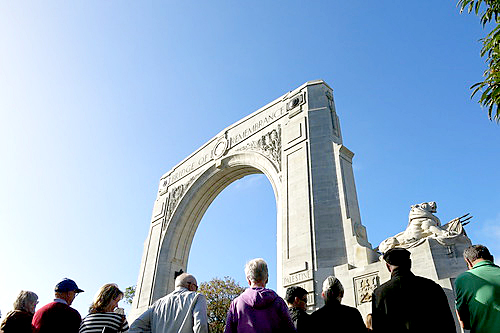
The Bridge of Remembrance opened on Armistice Day, November 11, 1924, to commemorate those who had lost their lives during World War 1.
About 4500 military personnel from Christchurch were among the 16,697 Kiwis who died.
The Christchurch Memorial RSA is organising an event, which will start at the bridge on Monday at 9.30am.
RSA president Jim Lilley said the ceremony is about remembering those who marched across the old Cashel St bridge on the way to war.
"Anzac Day parades are getting bigger and bigger it seems throughout New Zealand.
"Armistice Day is a little less recognised."
Armistice Day on November 11 recognises the end of WW1.
"So this will be about acknowledging the end of World War 1, the supposed war to end all wars," he said.
Representatives from the 2/1st and 2/4th infantry regiments of the army, New Zealand Royal Navy members and veterans will march over the bridge after 10am, led by the New Zealand Army Band.

The Christchurch Highland Pipe Band will also play.
Lilley said the bridge is an integral part of military history because many soldiers marched across it before departing from Lyttelton to fight in the war.
There will also be an Armistice Day 105mm howitzer salute in North Hagley Park.

The artillery will fire three rounds again at 11am, symbolising the moment the guns fell silent on the battlefields in 1918.

Any veterans are encouraged to join the parade.
History of the Bridge of Remembrance
New Zealand sent 98,950 men to fight in the war, about 10 per cent of the population.

After WWI, there were competing ideas for a war memorial in Christchurch with some favouring a cenotaph and others supporting a bridge and archway over the Avon River on Cashel St.
The location is considered significant because many soldiers staying in the nearby King Edward Barracks, crossed the bridge on their way to Lyttelton to go to war.

The bridge was opened on November 11, 1924, on Armistice Day with a ceremony also recognising 10 years since the start of WWI in 1914.
The Governor General and admiral of the Royal Navy, Lord John Jellicoe, led the proceedings.
He also laid the bridge’s foundation stone on Anzac Day in 1923.
Built from Tasmanian stone, the bridge features a prominent central arch with two smaller arches on either side.
Christchurch artist Frederick Gurnsey carved the memorial's other symbols, including the wreath and laurel leaves.












